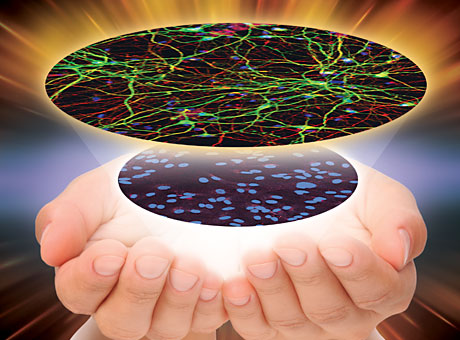
Human skin cells (bottom) can be converted into medium spiny neurons (top) with exposure to the right combination of microRNAs and transcription factors.

Human skin cells (bottom) can be converted into medium spiny neurons (top) with exposure to the right combination of microRNAs and transcription factors.
Scientists have described a way to convert human skin cells directly into medium spiny neurons that are important for controlling movement. These are the primary cells affected in Huntington’s disease. Unlike other techniques that turn one cell type into another, this new process does not involve passage through a stem cell phase, and avoids the production of multiple cell types.
In the study, researchers converted adult human skin cells into medium spiny neurons with exposure to the right combination of chemical signals. They then injected these converted cells into mice brains.
Reporting in the journal Neuron, the researchers showed that these converted cells survived at least six months after injection into mice brains and behaved similarly to native cells in the brain. “Not only did these transplanted cells survive in the mouse brain, they showed functional properties similar to those of native cells,” said senior author Andrew S. Yoo, PhD, assistant professor of developmental biology.
The ability to convert adult human cells may present the possibility of using a patient’s own easily accessible cells, which will not be rejected by the immune system.
To reprogram these cells, Yoo and his colleagues put the skin cells in an environment closely mimicking the environment of brain cells. From past work, they knew that exposure to two small RNA molecules could turn skin cells into different types of neurons.
In a skin cell, the DNA instructions for how to be a brain cell, or any other type of cell, is neatly packed away, unused. In past research published in Nature, Yoo and his colleagues showed that exposure to two microRNAs (miR-9 and miR-124) altered the machinery that governs packaging of DNA. Though the investigators still are unraveling the complex details, these microRNAs appear to be opening up the tightly packaged sections of DNA important for brain cells, allowing expression of neuronal genes.
Knowing these microRNAs could change skin cells into a mix of neurons, the researchers finetuned the chemical signals, exposing the cells to additional molecules called transcription factors, which are present in the part of the brain where medium spiny neurons are common. The investigators showed that the transcription factors guide the skin cells to become a specific subtype of neuron.